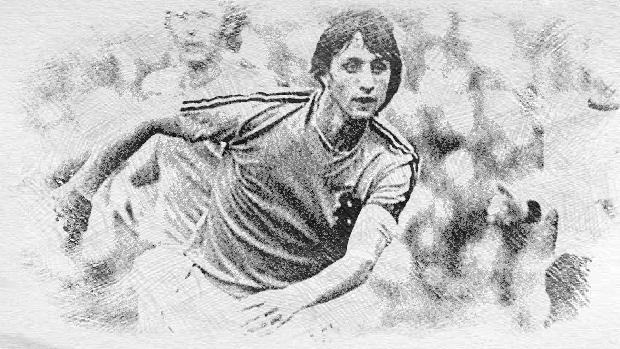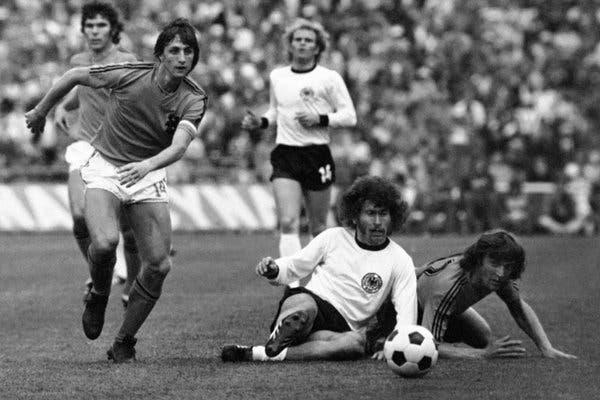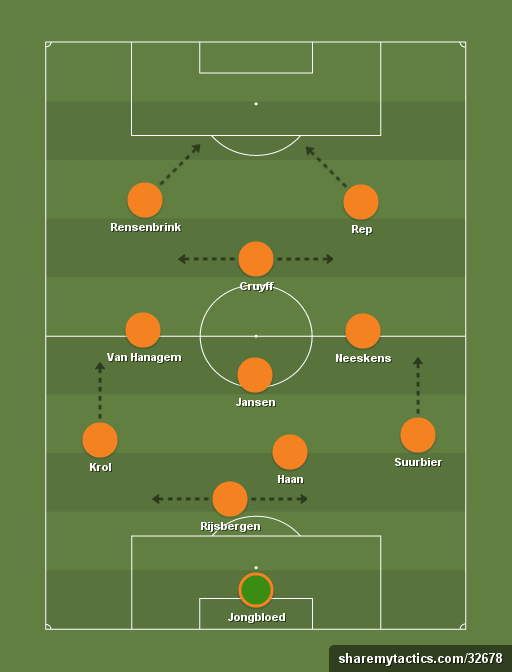
Recreating Total Football in FM20
Is it Possible in a Football Manager Game?
1974. To some football enthusiasts (and Ajax fans), this was the year when football reached its apotheosis as a sport. The highest point in the development of the beautiful game, when it was the closest it would ever be to an art-form. Some would even argue that the game has been on the downturn ever since, as the sport gets more and more violent and mechanical and VAR discussions dominate the media. But let’s go back to the Summer of 1974 when Ajax, Johan Cruyff and Netherlands dominated Europe. Let us recreate the magic of Dutch Total Football!
“In my team, the goalie is the first attacker, and the striker the first defender”. – Johan Cruyff
Dutch Totaalvoetbal was unique in how it revolutionized the movement of the ball. It preached dynamic positional swapping, as every player played in every position. At times this left the opposition clueless. The world never saw anything like it before. And after the Dutch dream team of the 1970s dissolved, there hasn’t been anything like it. Football historians of course will state that Barcelona’s Tiki-Taka and Guardiolas’s Juego de Posición system are natural continuations of Dutch Total Football. I would argue that while they retain some of the elements of Totaalvoetbal, they are not quiet the same.
“The only team I’ve seen that did things differently was Holland at the 1974 World Cup. Since then everything looks more or less the same to me. Their ‘carousel’ style of play was amazing to watch and marvelous for the game.” – Carlos Alberto Torres, captain of Brazil’s 1970 World Cup-winning team.
Defining Total Football
It is easy to confuse Total Football of 1970s with the more modern systems such as Barcelona’s Tiki-Taka or Gegenpress. After-all, many modern managers such as Pep Guardiola, Marcelo Bielsa and Jurgen Klopp, were influenced by the Dutch free-flowing approach. Johan Cruyff himself was instrumental in bringing the Dutch football culture to Barcelona which defined its club DNA ever since. But while Total Football, as first played by Ajax and the Dutch National Team, took high defensive line pressing and very technical play to whole new levels, those things were not its only defining aspects. For that we need to look at the name itself. What does “total” stand for in Total Football?
To start we need to put Total Football in the context of its time and place. Netherlands in the early 1970s was a veritable Mecca for free-spirited liberalism that defined that era. In their typical fashion, the Dutch embraced the revolution that was happening in politics and culture at the time and made it their own. In that they went one step further by applying the new liberal mentality to the field of sports. Total Football was their answer to the rigid systems that dominated football scene up to that point. And neither Italian Catenaccio nor the very English 4-4-2 could stand a chance against the new Dutch 4-3-3. Yet the shape by itself was not what made Total Football. Although as I will show soon, there were reasons why it fit the system so well.
Space is Key
The “Total” in Total Football is a reference to its two key elements, complete positional fluidity and utilization of the space to the fullest. Pressing and possession were just tools used to put pressure on the opposition. Alone they allowed Ajax to gain optimal scoring positions and dictate the play on their own terms. As the opponents scrambled to react to Cruyff and co’s smart movements, space was freed up.
The need to consistently create space was key to the concept of Total Football. Hence it was the fluid positioning and spatial awareness that most defined Total Football. And not just high possession, pressing and short passing which became the main aspects of tiki-taka and gegenpressing. So while these two schools of football learned from Total Football, they did not recreate it. You can’t take Mo Salah from his advanced attacker position and plomp him down in defensive midfield and except Liverpool’s gegenpress to work as well. While in Dutch 4-3-3 Cruyff had no qualms in interchanging positions with midfielders.
Total Football happened because of the coming together of two people in the right place and time. The time and place were right because of the earlier mentioned innovation in technology and culture of 1960s Netherlands. Also it was at the best possible club. Amsterdam’s Ajax. Not surprisingly the Dutch club was famous for championing youthful development and openness to difference. There the paths of two individuals crossed. The two were Rinus Michels and Johan Cruyff.
The Tale of Two Visionaries
The creation of Total Football can be attributed to Johan Cruyff, probably the most famous Dutch footballer of all time, and his manager at Ajax (and later at the Dutch national team and Barcelona) Rinus Michels.
The earlier quote comparing Dutch style of playing to carousel, is spot on. Ajax really played like no other and it started under Michels. What differentiated Rinus Michel’s teams from those that came before and after is in how players covered each other on the field. It involved a whole lot of vertical switching and position swapping as players seamlessly moved into spaces liberated by their teammates. There is some exaggeration there, due to the legend build around it. I doubt that Cruyff excelled as much as a fullback as he did in dropping deep and helping in the midfield battle. Much in the same way that De Bruyne or David Silva do today.
Rinus Michels used his own playing experience and knowledge of football history to come up a fluid tactical system. The idea that any player should be able to play any position on the field as well the fluidity of movement were not completely new at the time. Several prior teams already found success practicing a type of Total Football philosophy without calling it that.
Jack Reynolds laid the foundations while he managed Ajax through the 20s and 40s. Michels learned under him as a player. In Hungary Gustav Sebes created magic with the Hungarian national team during 1950s. Hungarians astounded all with their free-flowing passing and shadow movement. The Magical Magyars in turn drew inspiration from the English tactical pioneer Jimmy Hogan. Also in the 50s, Harry Potts led Burnley to win the English League title by using the system of fluid positional interchange.
So the concept of a fluid football was not all that original even before 1974. Not even the False 9 striker role that facilitated this fluidity (by dropping very deep) was new to Ajax. In fact, one of the inspirations for Hungary’s Golden Team and the way Puskas played was the Argentinian club River Plate. Dubbed La Máquina (The Machine) since it perfected the “false nine” role and used the interchangeable attack roles as “cogs” in the machine. Even the high press that the Dutch became known for, was concurrently developed by Viktor Maslov at Dynamo Kyiv.
While he perfected Total Football at Ajax, Michels was lucky to have a perfect False 9, Johan Cruyff, playing for him. Cruyff understood what Michels was trying to do immediately and instinctively. He was an exceptionally intelligent footballer who used his tactical brain and sublime technique to outsmart opponents, exploit space and direct teammates. Thus Cruyff served as the on-field general for Michel’s Total Football army. He eventually became synonymous with Total Football style. One cannot talk about Total Football without mentioning Johan Cruyff and the False 9, a role he made his own.
Simple Football
“Playing football is very simple, but playing simple football is the hardest thing there is”. – Johan Cruyff
Total Football is not easy to recreate faithfully in Football Manager. Its success depends much on the players, in particular their ability to quickly switch positions in context to on-field situation or to confuse opponents. It requires them to be comfortable in multiple roles. For this you will probably need very intelligent and technical players.
Also, having a player that moves out of his position be replaced by teammate from another position is not something that FM20 can model accurately. Ideally in the fluid Total Football system no outfield player is fixed in a predetermined role. Anyone can successively play as a striker, midfielder or defender. The only player who must stay relatively put is the keeper. And even then Ajax’s keepers played as liberos sometimes. The best we can do is try to make the tactic as fluid as possible with plenty of roaming roles and a lot of individual license for player expression. And of course it all falls apart if you do not have a team full of intelligent team players and hard workers.
So starting from the top, naturally you will need a very good False 9. This will probably be your team’s best player and one the whole tactic will center around. On both sides of the “striker”(I’m calling him a striker but he really should be your forward/attacking midfielder/defensive midfielder all in one) you have two creative wide players. Both need to be roaming, creative roles but one needs to be more of an attacker/runner. He will focus more on aggressively exploiting the space created by the false 9. The other winger will focus more on support.
Flanking the false 9 are also two mezzalas. I tried to make their roles complimentary to the wingers. So the right mezzala is on attack and the one on support is behind the left attacking winger. In the middle, contributing to the strong backbone of the tactic, is the central midfielder on defend. But this should be not your typical destroyer/hard tackler. Rather I envision someone who is both very creative and defensively responsible (decent positioning) like Christian Eriksen or Lo Celso.
So this is how I would make up the first three lines in the 4-3-3. The main advantage of sticking to this classic Dutch formation is the ease with which you can control possession by having three attackers and three midfielders. So despite its legend of fluidity, the Dutch team of 1974 still stuck to a pretty traditional 4-3-3 shape. That meant having a tackler (Wim Jansen), a runner (Johan Neeskens) and a passer (Willem van Hanegem). In attack there was of course the false 9 Johan Cruyff and two wide attackers – Johnny Rep and Rob Rensenbrink.
Swap to Success!
Another, hidden benefit of using a 4-3-3 to recreate Total Football in Football Manager is due to position swapping. I modeled the vertical position switching, by having each player in attack match another player in midfield. What I mean is that I assign each one of the three attackers, to swap with another player from midfield. The false 9 will be switching with the attacking mezzala, raumdeuter with mezzala (support), and central midfielder with winger (support). It helps when you have a team with attackers and midfielder who are all adept in attack, defense and creation. And even though I use a raumdeuter role, it is mostly for its more aggressive, roaming, space exploitation aspects. It plays somewhat different when you use a creative player like Christian Eriksen there.
To reiterate on the position swapping, I want my striker to spend as much time in the midfield as in attack. While the central midfielder ideally will act as a wide attacker half the time. Partly this will confuse the opponent and make it harder for them to individually mark my players. But also I want my players to recreate the element of unexpected that made Holland so difficult to play against in the 1970s.
You will also notice that I use no playmaking roles. That is because ideally, all of your front six should have the mental and technical ability to be a playmaker. The point of the tactic is to give them as much freedom as possible to dictate the game. To both create and finish. Here is where stylistically the style of Total Football blurs somewhat with Brazilian Joga Bonito style. And even in its time, the Dutch footballers were sometimes seen as Europe’s answer to Brazilians.
All you need is teamwork …
…With a good serving of technique and tactical understanding.
Those I would say are the three main characteristics for any player in Total Football system. As you see in the image above, they featured prominently in the 14 rules that Cruyff came up with in his autobiography. They now serve a guideline to the Johan Cruyff Award, given to outstanding young Dutch footballers. In developing my Total Football tactic I would like to take four of them to use as a guideline to define the required attributes for the ideal Total Football DNA.
- Team Player – Teamwork, Work Rate and Determination.
- Technique – Technique, Passing, First Touch
- Tactical Understanding – Anticipation, Composure, Decisions, Positioning Off the Ball, and Vision.
- Creativity – Flair
And one that is not up there but is still very important, is Stamina. Total Football can be very demanding both mentally and physically.
Having decent marking, tackling and positioning across all positions is always a bonus. Especially because we are using a very fluid mentality and asking all your players to do a lot. To elaborate, I do not mean that only the above attributes are required for a good Total Football system. You will definitely need very well-rounded players, meaning decently good in almost all attributes. But if they excel in the ones listed, the tactic should be that much more effective.
So once you have a good core of players with these attributes then you can start building your Total Football system around them. Thus it is probably one of the hardest tactical approaches in Football Manager simply because the very specific players needed. There are few teams outside of Barcelona or Liverpool that have such players from the get-go. But through careful transfers and some luck in youth development, it is very achievable. Even Ajax itself is not a bad candidate. They have three or four players that fit the criteria while some of their young prospects have enough potential to be molded into it. However if you want a fun experiment with Total Football from the start, then the best team is a rather surprising one.

The perfect team that you can use to recreate Total Football in FM20 is actually Tottenham. Spurs have a number of players who personify Cruyff’s ideal of hard working and intelligent team players. Their front six are also very creative. They have five players that could easily be the primary playmaker on a mid-level team.
I created a player selection screen custom filter which outlines all the required attributes for Total Football, in my opinion. As you can see the Spur’s First Team possesses quite a few of them, based on the amount of green. I was not able to include the download for this due to time restraints. For those who are interested, I will be updating the article with both the filter and the tactic itself. Check back very late tonight.
Legacy of Total Football
We must not forget the debt that managers such as Marcelo Bielsa and Pep Guardiola have to the brilliant work of Rinus Michels and Johan Cruyff. It is no secret that both Bielsa and Pep depend on their players switching positions or acting in unusual ways (such as a midfielder playing as an inverted wingback). In fact Guardiola’s famously successful Positional Play with its vertical overloads is only possible because of Total Football. And as I hope this article showed it is a uniquely influential tactical philosophy. It might be difficult to recreate but at least theoretically should be possible in FM20. Hopefully you enjoyed this read. For any suggestions or comments, please let me know below. If there is enough interest I might do an update feature or two. Total Tottenham 🙂 ?
Here as promised is the tactic I am using (although my system is really more about the correct player DNA): https://ufile.io/encqy34m
And the custom player DNA view: https://ufile.io/qt7qzixf
Feel free to follow us @ Dictate The Game’s Facebook and Dictate The Game’s Twitter











15 thoughts on “Recreating Total Football in FM20”
Muy buen articulo…..
Lo que digo siempre….. enlace de táctica según autor para poder probarla…
Gracias…
I had no time to include it with the article. But I will update it late tonight with both the tactic and my custom Total Football player selection filter. Check back in about 4-5 hours 🙂
Your article is very interesting! I always had the ‘dream’ to replicate total football in football manager…please continue with your work and show us how the tottenham could play like 70’s Holland! 😉
is there any player instructions or do we leave it as it is
is there any opposition instructions or do we leave it to our assistant
I think the only player instruction I put was telling inverted winger to stay wider and attacking mezzala to dribble more. And i don’t use opposition instructions, always leave it to my assistant
I cant seem to click on the links for tactic and attribute filters? Can anyone help?
Hi Thomas. Thanks for reading the article.
The links should now work.
Luke
what do u do for training ?
Nothing special. I do like to use the template for gegenpress training that the game provides. I find it develops the attributes i value especially mental and physical.
Muy buena
Hi ! Why don’t you use “underlap left”?
Thank you for answer !
Actually it’s so as not to increase the individual mentality of my left wingback.
I don’t suppose it would be possible to update the download links? I would really like to try this out. Thanks.
Sorry I dont have those anymore. It was on an old version of FM that I uninstalled some time ago